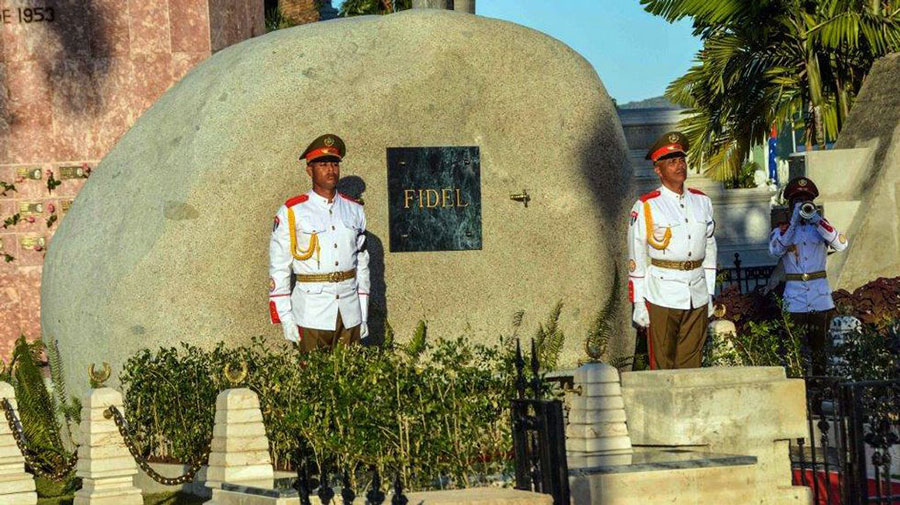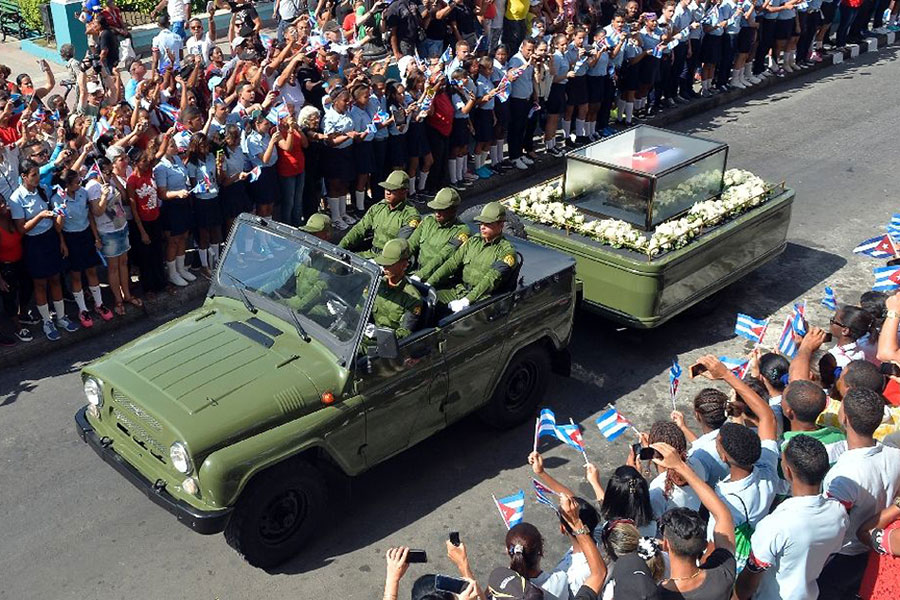Following nine days of national mourning, Cuban Leader Fidel Castro’s ashes were buried on Sunday morning in a cemetery of Santiago de Cuba, the city where the socialist revolution began 63 years ago.
Hundreds of Thousands said farewell with a combination of tears, to a leader that ran the destiny of the island for more than five decades. His ashes were placed in the niche of a boulder. Cuban President Raul Castro placed the wooden box where the cremated remains of his brother rest in a 10-feet rounded stone at the Santa Ifigenia Cemetery. As well, an emerald plaque with the word “Fidel” was fixed on the tomb.

“It’s a privilege to have him here,” said Cruz Maria Pardo, 64, a Cuban woman who has worked cleaning the mausoleums in the cemetery for more than two decades. She also said that trucks have been taking in materials during a year.
Cuba after Fidel
It ‘s hard to describe Cuba’s history without mentioning Fidel Castro. In 1953, Fidel decided to start a revolution that still lives today and that have influenced not only the lives of the Cubans but those of other Latin-American countries. Fidel died on November 25th at the age of 90.
The world was shocked to hear about the news. As well, different global leaders such as Mauricio Macri, Nicolas Maduro, Evo Morales, Justin Trudeau and others sent their condolences to Castro’s family and the Cuban people. Though Raul has been officially the president since 2008- due to Fidel’s intestinal ailment – everyone regarded Fidel as the leader of Cuba. He certainly gave Cuba an influence in the global affairs as it never had before.
After nine days of official national mourning, Cuba accompanied Castro to Santiago de Cuba, where his ashes were buried on a Sunday morning ceremony at the San Ifigenia Cemetery. They were crying and singing “I am Fidel.” Castro’s cremated remains rest in a ten ft. rounded stone, with a dark place where “Fidel” is engraved.
The Cuban government carefully planned the details of the funeral service. It was private and closed to the media. It followed a short cortege around the city where 21 guns were shot. Castro rests near to the burial site of Jose Martí, a 19th-century Cuban independence fighter, considered the father of Cuba.

The revolution history is concentrated in the San Ifigenia Cemetery
Castro’s resting place was a sort of enigma just a few days ago. It all was revealed today morning as the world took a glimpse of the tomb that will surely become one of the most visited sites on the Caribbean island. The private ceremony ended before 9 a.m. Then, journalists and Castro’s supporters were allowed into the cemetery to see Castro’s resting place
But the truth is that the site has a lot of history to tell, beyond Castro. The tomb stood next to the memorial to the rebel soldiers who died in the attack that was led by Fidel Castro in Santiago’s Moncada barracks on July 26, 1953, a date that is remembered in Cuba as the day when the revolution started during Batista’s dictatorship.
As well, it is in front of independence hero Jose Marti’s mausoleum. At least a dozen uniformed soldiers were standing in front of Castro’s tomb.
“All of the revolution’s history is concentrated at that cemetery,” said Jose Francisco Guillot Castillo, 59, a cook in an oil refinery who lives in a house with a tin roof.
Moreover, there in the Santa Ifigenia cemetery also lies the tomb of Compay Segundo, the singer and guitar player who was worldwide known as a member of the Buena Vista Club, his tomb has the image of a golden guitar. Other historic figures also lay there such as Emilio Bacardi Moreau, who managed his family’s rum dynasty and died in 1922. The Bacardi family left Cuba as Castro nationalized their properties in the early years of the revolution.

Will it be opened to public?
The location of Castro’s tomb was of the most tightly kept secrets in Cuba. However, according to some workers of the cemetery, trucks had been going to the cemetery to deliver some materials for more than a year. The cemetery is located in the northwestern part of the city of Santiago of Cuba, about a half-kilometer from the bay. It was founded in 1868.
During the last four days, Thousands if not millions of Cubans have lined the central roadway connecting the island’s two largest cities, chanting and crying for Castro. All are waiting under the Caribbean sun to say goodbye to their leader.
No official comments have been made regarding a future access to Castro’s tomb, but its apparent location alongside Marti’s – which has been a heavily visited site for tourists and Cubans – indicates that it will continue accessible for people.
Despite all the controversies Castro’s government raised in the international community regarding human rights violations, people in Cuba was affected by his death.
Some have put the Cuban flag alongside phrases like “I am Fidel” on their doorways. This has certainly been a week to remember and to reflection about the achievements and promises made during the “Castrismo.”
Source: The New York Times
